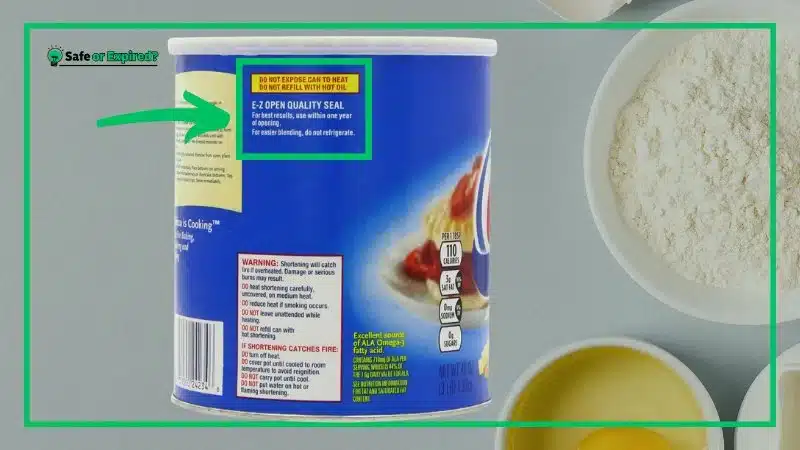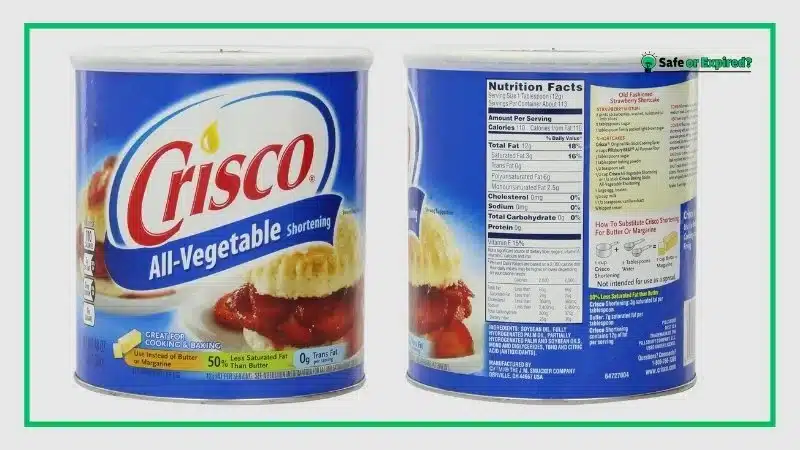“Does Crisco go bad?” You might wonder as you pull out that tub from the back of your pantry. Yes, it does go bad, but there are several ways to keep it fresh longer! Stay till the end to uncover simple yet effective tips for preserving your Crisco, ensuring you never have to toss out a good batch prematurely.
Keep reading.
Does Crisco Go Bad? Everything You Should Know
Crisco does go bad but has a long shelf life. It can last up to 2 years unopened and 1 year after opening if stored properly. Always check for any odd smells or discoloration before use, as these are signs that the Crisco has gone bad.
Does Crisco Go Bad in the Refrigerator?
Storing Crisco in the refrigerator can extend its life, but it is not necessary. If kept in the fridge, Crisco can last slightly longer than its typical shelf life, especially in warmer climates. However, it should still be used within a year of opening.
You may be wondering, “Do You Refrigerate Shortening After Opening?” Well, refrigerating shortening after opening is not required. Shortening can be stored in a cool, dry place such as a pantry.
This takes us to another question, “How Long Does Crisco Last Unopened?” Unopened Crisco can last up to 2 years when stored in a cool place. The expiration date on the label/packaging can be used as a guideline; however, if stored properly, Crisco may remain safe to use beyond this date.

Here’s a detailed table that outlines the shelf life of Crisco under different storage conditions:
| Storage Location | Shelf Life (Unopened) | Shelf Life (Opened) |
| On the Counter | Up to 2 years | Up to 1 year |
| In the Refrigerator | Up to 2 years | 1-1.5 years |
| In the Freezer | Up to 2 years | Up to 2 years |
Can Expired Shortening Make You Sick?
Using expired shortening can potentially make you sick. Although it may not be harmful immediately after the expiration date, as time passes, it can develop rancidity and mold, which can cause foodborne illnesses if consumed.
How Long Can Expired Crisco Shortening Hurt You?
Expired Crisco shortening can be harmful if consumed long after its expiration date, as it can turn rancid or grow mold. The risk of illness increases significantly the longer the shortening is used beyond its intended shelf life.
Potential Health Issues from Expired Shortening:
- Food Poisoning: Rancid fats can harbor harmful bacteria that may lead to food poisoning symptoms such as stomach pain, nausea, vomiting, and diarrhea.
- Digestive Issues: Consuming spoiled fats can upset the stomach and lead to digestive discomfort or more severe gastrointestinal issues.
- Unpleasant Taste and Odor: Rancidity can cause an unpleasant taste and smell, making food unpalatable.
- Nutritional Loss: Rancid fats lose their nutritional value, including essential fatty acids and vitamins.
Always check shortening for any off smells, tastes, or visible mold before use, especially if it’s past the expiration date.
How Do You Know if Crisco Has Gone Bad? Key Signs
You can tell if Crisco has gone bad by checking for any off-odors, unusual flavors, or a change in texture. Typically, expired Crisco may smell rancid or stale. If the color has darkened or it appears grainy or slimy, it should not be used.
Unusual Smell
If your Crisco smells off, like old nuts or something sour, it’s not good anymore. Fresh Crisco shouldn’t really smell like much of anything. When oils in Crisco break down, they start to smell bad. This happens if Crisco gets too warm, sits out too long, or gets too much light.
Changed Texture
Crisco should feel smooth and kind of like thick lotion. If it feels sticky, slimy, or has little hard bits, it’s gone bad. Sometimes, if Crisco is kept in a warm place or gets water in it, it can start to change. This makes it not work right when you’re cooking or baking.
Altered Color
Crisco is usually a nice, light white color. If you see it turning yellow or find green or black spots (that’s mold!), it’s not safe to use. Crisco can change color if it’s not stored right, like if it’s near a window or in a damp place.
Greasy or Oily Separation
Crisco should maintain a uniform consistency. If you notice that the shortening starts to separate, with oil beginning to pool or create layers distinct from the solid mass, it’s a sign that the product is breaking down. This separation often occurs due to fluctuations in temperature or when Crisco is nearing the end of its shelf life.
Taste Alteration
While it’s not recommended to taste Crisco regularly, if you suspect it might be going bad and decide to test it, a noticeable change in taste can be a definitive indicator. Fresh Crisco should have a neutral, bland taste. If it tastes bitter or metallic, this is a sign that oxidation has occurred, and it should no longer be used.
By checking these things—smell, texture, and color—you can make sure your Crisco is okay to use. This helps keep your food tasty and safe to eat!
There’s more.
Understanding why food spoils is just as important as knowing how to prevent it. Explore the causes and how to counteract them in “13 Common Reasons Why Foods Spoil and How to Prevent It.”
How to Extend Crisco Shelf Life? Proven Tips
To extend the shelf life of Crisco, store it in a cool place, tightly seal the container after each use, and consider refrigeration to keep it fresh longer. These simple steps can significantly prolong its usability.
Store in a Cool, Dry Location
Keeping Crisco in a cool, dry spot, like a pantry away from the stove or any heat sources, helps prevent it from going bad quickly. Heat can make the oils in Crisco break down faster, leading to rancidity. A consistent, moderate temperature is ideal to maintain its quality over time.
Keep the Container Tightly Sealed
After using Crisco, make sure to close the lid tightly. This prevents air from getting in. Air can cause Crisco to spoil faster because it carries moisture and other elements that can affect the fat. Using a clean spoon every time you scoop some out also helps avoid introducing any contaminants that might spoil the Crisco.
But all in all, keeping it tightly sealed/packed is enough.

Consider Refrigeration
If you don’t use Crisco often or live in a warm climate, storing it in the refrigerator can help extend its shelf life. Cold temperatures slow down the rate at which the fats in Crisco break down. This means you can keep it longer without it going bad.
Often, we come across various myths about keeping food fresh that can do more harm than good. Learn to distinguish fact from fiction by reading – “Debunking 10 Common Food Preservation Myths.”
Use Smaller Containers
People often ask, “How to store shortening after opening?” Well, use containers. Also, if you buy Crisco in bulk, consider dividing it into smaller containers. This way, you only open what you need.
Each time you open a large container, you expose all of the Crisco to air, which can accelerate spoilage. Smaller containers reduce this exposure and help maintain freshness.
Avoid Using Wet Utensils
When scooping out Crisco, always use dry, clean utensils. Introducing moisture into the Crisco can lead to mold growth and spoilage. Moisture disrupts the stability of the fats, potentially causing them to go bad much quicker than they would in a dry environment.
Check Regularly for Signs of Spoilage
Regular checks can help catch early signs of spoilage, such as off smells, unusual textures, or discoloration. By monitoring your Crisco regularly, you can ensure it’s still good to use and avoid using spoiled products in your cooking.
Store Away from Strong Smells
Crisco can absorb odors from other foods, especially in a refrigerator or a pantry packed with various items. Store it away from foods with strong odors, like onions, garlic, or spices. Ideally, place it in an airtight container, even within the pantry, to protect it from taking on any unwanted smells that could affect its taste and quality.
Rotate Your Stock
If you use Crisco regularly, practice the “first in, first out” (FIFO) method. This means using older Crisco containers before newer ones. Keeping track of when you open each container can help ensure that none sits unused for too long, reducing the risk of it going bad before you get a chance to use it.
By following these additional tips and being mindful of how you handle and store Crisco, you can significantly extend its shelf life.
Now, you know effective food storage is key to prolonging the life of your groceries. For easy and practical tips that you can apply in your kitchen today, don’t miss “Essential Tips for Storing and Preserving Your Food.”
Conclusion
In conclusion, understanding how to maintain the freshness of Crisco can save you both time and money by preventing spoilage. Here are the key takeaways to remember:
- Know the Shelf Life: Remember that Crisco can last up to two years unopened and one year after opening.
- Store Properly: Keep Crisco in a cool place/location.
- Check Regularly: Look for spoilage signs, like odd smells or discoloration.
- Use Right Containers: Store in airtight containers to minimize exposure to air and moisture.
By following these guidelines, you’ll ensure that your Crisco remains fresh and safe for cooking and baking, helping you whip up delicious meals without a hitch.

